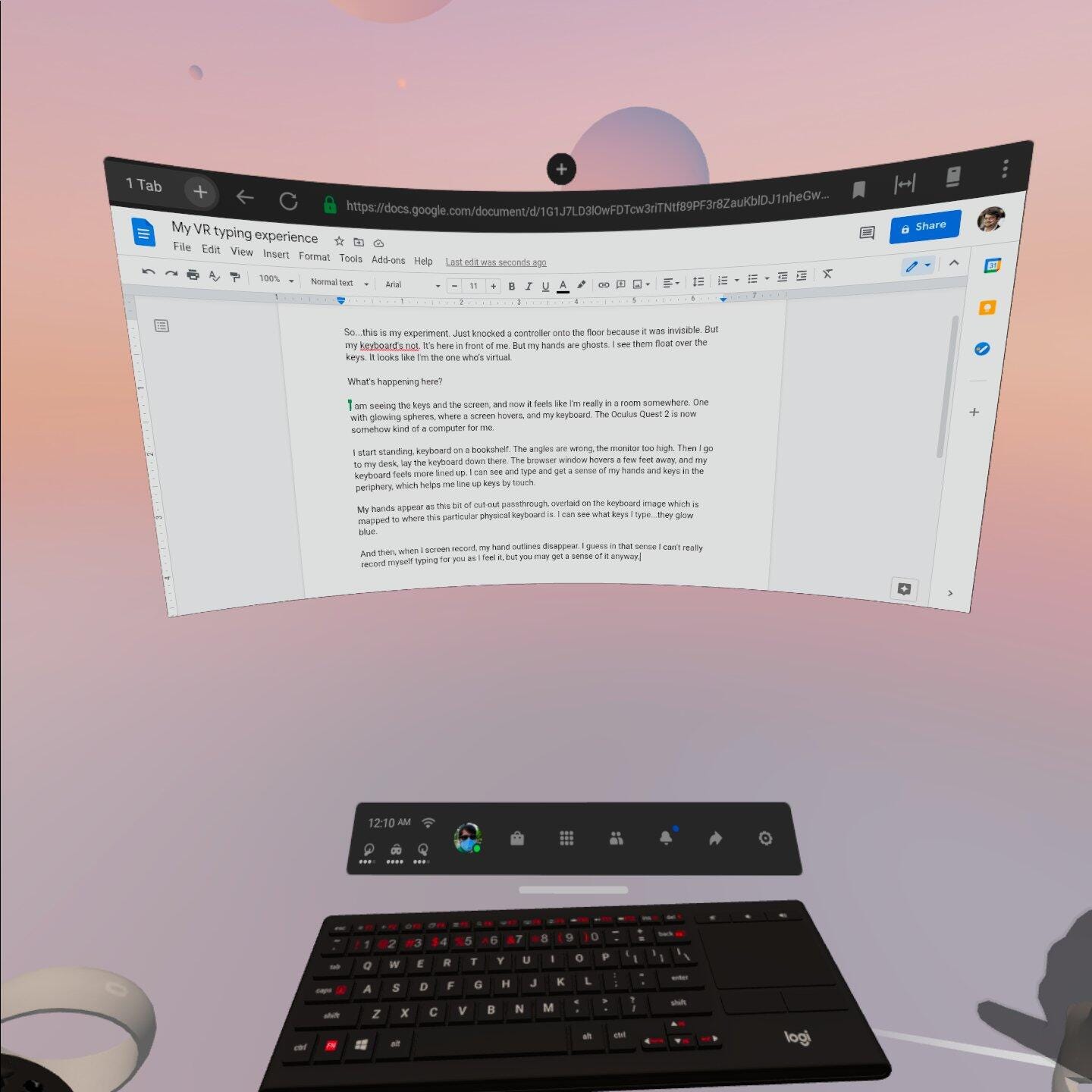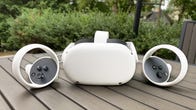Typing in VR: Tips on how to join a keyboard to your Oculus Quest 2
The Oculus Quest 2 and the Logitech K830 keyboard. Laptop replacement? Not yet.
Scott Stein / CNET
So … this is my experiment. Just threw a controller on the floor because it was invisible. But not my keyboard. It’s here in front of me. But my hands are ghosts. I see them hovering over the keys. It looks like I’m the one who’s virtual.
What’s happening?
That was the first thing I typed when I paired a bluetooth keyboard with the Oculus Quest 2 and points the browser to Google Docs. Thanks to a new software update, type and see your hands hover over a virtual keyboard renewal is now possible. Experimental, but possible.
I also wrote the following:
I see the buttons and the screen, and now I really feel like I am in a room somewhere. One with glowing spheres with a screen floating in them and my keyboard. The Oculus Quest 2 is kind of a computer for me now.
I try standing, keyboard on a bookshelf. The angles are wrong, the monitor is too high. Then I go to my desk and put the keyboard there. The browser window floats a few feet away and my keyboard feels lined up. I can see and type my hands and buttons on the periphery and get a feel for my hands and buttons, which helps me align buttons with touch.
My hands appear as a piece of cut-out passthrough overlaid on the keyboard image associated with the location of that particular physical keyboard. I can see which keys I am typing … they are glowing blue.
And then when I record on the screen, the contours of my hand disappear. I guess on that note I can’t really record how I feel as I type for you, but you can still get a feel for it.
And now my hands don’t come back
Here they are again.
To try this VR trick for yourself, you need Oculus Quest Operating system V28which is now being rolled out on headsets. You also need a specific keyboard: the Logitech K830. The K830 has Bluetooth and its own trackpad and buttons. Go to the Oculus Quest settings and make sure hand tracking is enabled, then you can pair the keyboard and enable keyboard tracking in the experimental features.
What the keyboard looked like in VR while I was writing this story. I could also see my ghostly hands, but they don’t appear in screenshots (ghostly).
Scott Stein / CNET
Not everything worked for me at first: I restarted the headset and then reset all the experimental settings to the default settings. Then it tried again and it kicked in. (Some people on Reddit suggest a factory reset is required, but I didn’t go that far).
You can pair any Bluetooth keyboard and mouse with an Oculus Quest 2, but the K830 has the added benefit of being visible in VR and triggering the hand-passthrough effect.
How to set it up:
1. Go to the Oculus Quest Settings Experimental functions Section and find the Bluetooth pairing Opportunity. Tap the pairing button to connect the keyboard. Make sure that hand tracking is also activated – this is in the general settings.
2. Once that’s done you can try that Track keyboard Setting in the experimental functions to adjust the opacity of your ghostly hands. (This sets how much you can see through them on the keyboard.) But that didn’t work for me, so I ignored this step.
3. The K830 keyboard should appear like a graphic representation of it at the top of the Oculus main menu.
4th. If you don’t see it, try resetting the Experimental Features settings back to the default, which worked for me. Make sure your keyboard is turned on. If that doesn’t work, restart Quest 2.
The keyboard needs to sit still for proper tracking, so you’ll need to place it on a flat desk. Also, Oculus suggests that room lighting shouldn’t be too dark. As I put my hands near the keyboard, I saw my ghostly hands and fingers appear over it. Strange but interesting.
If you only subscribe to one CNET newsletter, this is the case. Get the top tips from the editors of the most interesting reviews, news, and videos of the day.
It was off-putting at first, and I didn’t have the same sense of key perception that I usually have on a laptop (or even a phone or tablet). The craziest thing for me was that when I relaxed a little, I felt like I was sitting at the computer. The perception of my hands and the keyboard through my peripheral vision was enough to help me typing to stay on course.
There are a lot of caveats here: I used the Oculus browser and entered it into Google Docs. Even then, I received a warning that Facebook’s browser is not a supported browser for Google apps. It seemed to work fine, but be aware.
Other apps don’t seem to work with it yet. Submerged, an app that can expand my Mac to the Quest 2 and use the headset to stream multiple virtual monitors didn’t recognize the floating keyboard or my ghostly hands (it just makes me type invisibly, which you do with any keyboard be able) . The other VR browser on Oculus, Firefox Reality, didn’t seem to recognize the new passthrough typing effect either.
Could Facebook’s evolution of VR typing turn the Quest 2 into a Chromebook? A trip computer? What if Facebook tries to get this typing trick to work without a keyboard? I’m thinking about how my typing combined with my hand overlays could help Facebook train this future algorithm. My typing speed increased the more I used it. It was starting to feel natural.
But right now I’m not giving up on my laptop, tablets, or phones. The Oculus Quest 2 delves into the work tools, but the path ahead of them can be bumpy and experimental.
Look at that:
Oculus Quest 2 is better and cheaper … with a Facebook …
8:56




Comments are closed.